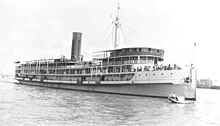HMSTeviot Bank
| History | |
|---|---|
| Name |
|
| Namesake | 1938:River Teviot |
| Owner |
|
| Operator |
|
| Port of registry | |
| Builder | J Readhead & Sons,S Shields |
| Yard number | 511 |
| Launched | 1 December 1937 |
| Completed | February 1938 |
| Commissioned | 1939 |
| Decommissioned | 1944 |
| Identification |
|
| Fate | Scrapped in 1971 |
| General characteristics | |
| Type |
|
| Tonnage | 5,087GRT,2,981NRT |
| Length | 423.7 ft (129.1 m) |
| Beam | 56.7 ft (17.3 m) |
| Draught | 25 ft0+1⁄4in (7.63 m) |
| Depth | 24.8 ft (7.6 m) |
| Decks | 1 |
| Installed power | 524NHP |
| Propulsion | |
| Speed | 12 knots (22 km/h) |
| Sensors and processing systems |
|
| Armament |
|
| Notes | Sister ships:Tielbank,Testbank |
HMSTeviot Bankwas aBank Linesteamshipthat was built inEnglandin 1938 as thecargo shipTeviotbank.In theSecond World Warshe was aRoyal Navyauxiliaryminelayer.By 1956 aPanamaniancompany had bought her and renamed herNella.She was scrapped inItalyin 1971.
This was the first of two Bank Line ships calledTeviotbank.The second was amotor shipthat was built in 1967, sold in 1979, and scuttled in 1993.[1]
Building & identification
[edit]In 1937 and 1938John Readhead & Sonsbuilt threesister shipsin their shipyard atSouth Shieldson theRiver TyneforBank Line.Tielbankwas yard number 509, launched in June 1937 and completed that August.[2]Testbankwas yard number 510, launched in September 1937 and completed that November.[3]Teviotbankwas yard number 511, launched on 1 December 1937 and completed in February 1938.[4]
Teviotbank's registered length was 423.7 ft (129.1 m), her beam was 56.7 ft (17.3 m) and her depth was 24.8 ft (7.6 m). Hertonnageswere 5,087GRTand 2,981NRT.She had a singlescrew,driven by a three-cylindertriple-expansion steam enginethat was rated at 524NHP[5]and gave her a speed of 12 knots (22 km/h).[6]
Bank LineregisteredTeviotbankatGlasgow.Her UKofficial numberwas 165927 and herwireless telegraphcall signwas GDGZ.[7]
Minelayer
[edit]After the UK entered the Second World War in September 1939, theAdmiraltyrequisitionedTeviotbankand had her converted into a minelayer. She had capacity to carry and lay 280mines.She was armed with oneQF 4-inch naval gun Mk V,oneQF 2-pounder naval gun,fourOerlikon 20 mm cannonsand fourVickers.50 machine guns.She wascommissionedas HMSTeviot Bank,with thepennant numberM04.[8]
Swedenwas exportingiron oretoGermanythrough ports inNorway.In March 1940,Teviot Bankand Royal Navy minelayingdestroyersfrom flotilla D20 were sent on Operation Wilfred, which was to two minefields off the Norwegian coast with the intention of preventing German cargo ships from reaching those ports. The minelayers were on their way to Norwegian waters whenGermany invaded Norwayon 9 April.Teviot Bankwas meant to lay a minefield offStadlandetin western Norway, but this was immediately cancelled to release her escort ship for fleet duty.[6]
In September 1940Teviot Banklaid 541 mines in fjords between theFaroe Islands,to restrict neutral shipping movements. In February 1941Teviot Bankwas damaged by a near miss off the east coast of Britain. She spent four weeks being repaired. In July 1941 she was transferred to reinforce ships laying theNorthern Barrage.[6]

By December 1941Teviot Bankwas inSingapore.She worked withKung Wo,anIndo-China Steam Navigation Company Ltd.passenger ship that had been converted into an auxiliary minelayer, to lay a largeanti-submarineminefield across the eastern entrance to thePort of Singapore.[6]
In March 1942Teviot Banklaid a minefield in the SouthPreparisChannel in theAndaman Islands.That December she laid a deep anti-submarine minefield at the entrance to theRed SeaoffAden.[6]
In 1944Teviot Bankwas sent west from theEast Indiesto lay a minefield in theMediterraneanoffAnzioin Italy, but she was diverted and the plan was cancelled. Later she laid a minefield offCapri.[6]
Post-war service
[edit]The ship was returned to her owners and resumed merchant trade asTeviot Bank.By 1956 the Compañía de Navegacion Nella SA had bought her and renamed herNella.She was registered under the Panamanianflag of convenience,[9]and her Panamanian call sign was HPVL. By 1959 her navigation equipment included wirelessdirection findingandradiotelephone.[10]
On 16 February 1971Nellaarrived inLa Speziain Italy to be scrapped.Ship breakingstarted on 23 February.[4]
References
[edit]- ^"Teviotbank".Wear Built Ships.Shipping and Shipbuilding Research Trust.Retrieved6 May2023.
- ^"Tielbank".Tyne Built Ships.Shipping and Shipbuilding Research Trust.Retrieved6 May2023.
- ^"Testbank".Tyne Built Ships.Shipping and Shipbuilding Research Trust.Retrieved6 May2023.
- ^ab"Teviotbank".Tyne Built Ships.Shipping and Shipbuilding Research Trust.Retrieved6 May2023.
- ^Lloyd's Register1938,TEV–THA.
- ^abcdefMason, Geoffrey (5 June 2011)."Royal Navy minelaying operations, Part 1 of 2".World War 2 at Sea.Naval-History.net.Retrieved6 May2023.
- ^Lenton & Colledge 1968,pp. 306, 308.
- ^Lloyd's Register1955,entry 2/33786.
- ^Lloyd's Register1959,Negosan.
Bibliography
[edit]- Lenton, HT; Colledge, JJ (1968).British and Dominion Warships of World War II.Garden City, NY:Doubleday & Co.
- Lloyd's Register of Shipping(PDF).Vol. II.–Steamers and Motorships of 300 Tons Gross and Over. London: Lloyd's Register of Shipping. 1938 – viaSouthampton City Council.
- Mercantile Navy List.London. 1939 – via Crew List Index Project.
{{cite book}}:CS1 maint: location missing publisher (link) - "New Entries, 2".Register Book.Vol. I Register of Ships. London: Lloyd's Register of Shipping. 1955 – viaInternet Archive.
- Register Book.Vol. I Register of Ships. London: Lloyd's Register of Shipping. 1959 – viaInternet Archive.
- Rohwer, Jürgen (2005).Chronology of the War at Sea 1939–1945: The Naval History of World War Two(Third Revised ed.). Annapolis, MD:Naval Institute Press.ISBN1-59114-119-2.
